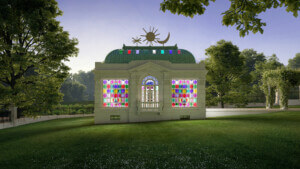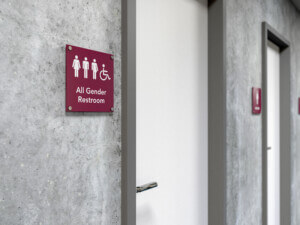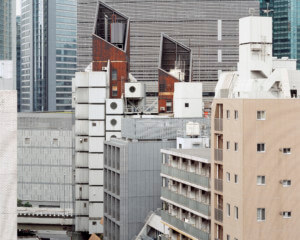Architecture anchors a cultural obsession with gendered space. As debate around bathroom access for trans and gender-nonconforming people continues, architects have an opportunity—an obligation—to shape the discourse by creating truly gender-inclusive spaces. On the 20th anniversary of Stud, architect Joel Sanders’s iconic book on queer male spaces, The Architect’s Newspaper invited Sanders and Alessandro Bava, of the London-based collective åyr, to discuss how gender informs the architecture of everyday life.
Alessandro Bava: What prompted you to put Stud together 20 years ago?
Joel Sanders: I would say that Stud was an outgrowth of two converging forces. Stud, you know, arose as a result of the urgent social issues that were prompted by the age of AIDS. I was especially influenced by a group of friends of mine who were part of a collective called Gran Fury. They were a group of artists and graphic designers who emerged out of ACT UP and were making these agitprops and were using visual culture to address an urgent issue. And I found myself wanting to think about how I could—as an architect—make a contribution to that cause.
The second overlapping force was the emergence of gender studies and queer theory in the 1980s and ’90s. Stud was very much influenced by work that had been done by queer theorists, in particular Judith Butler and her notion of performativity. Performing an identity is sort of enabled by architecture. Butler frequently referred to drag queens and drag kings, talking about their exaggerated gestures, makeup, their costumes, not as innate but performed. I took that one step further and looked at scenography, architecture, and ultimately the built environment as a stage
that enabled the performance of various gender roles.
In the introduction to Stud, you say that anything that threatens the supposed “masculinity” of buildings is to be erased and put to the side. For example, decoration has always been described as this feminine component to architecture. My interpretation is that architecture has been traditionally impermeable to any queer theory discourse. Do you feel the same way?
What was beginning to happen back then was that a first generation of architectural theorists was exploring issues of feminism as they impacted women. Architecture often belatedly absorbs larger academic trends. Many women critics were emerging—including a colleague of mine at Princeton, Beatriz Colomina, who would later come out with Sexuality & Space, as well as one of my teachers, Mary McLeod, and also others like Dolores Hayden and Catherine Ingraham, for example.
But at that time as far as I can tell, none of my colleagues were looking at the impact of masculinity or queer theory at that time. Queer theory was a younger discourse, and I was looking at how this new, emerging field of queer studies could impact and reshape how I was thinking as an architect.
You mentioned architectural theory. The emergence of queer theory also overlaps with deconstructivist architecture and Mark Wigley’s important show at MoMA [Deconstructivist Architecture]. Princeton was kind of unique in that I think there was a group of us who were decidedly interested in cultural studies and how they could impact architecture.
Books like Sexuality & Space are still quite iconic for this area of architecture theory. What other publications are of consequence in the discussion today?
Around this time we saw the rise of journals like Assemblage and October, and I think that history and cultural studies were gaining currency in the American architectural schools. I see it as a kind of short-lived Golden Age. Shortly after, American architectural culture became refocused on mostly formal issues that had to do with the impact of the computer for architecture, which is also important.
I think other academic disciplines like literature and history began to assume that cultural analysis involves thinking about the intersection of gender, race, and class as they’ve historically impacted different cultural discourses. And it became almost a matter of course that to be a responsible historian
or a responsible literary critic, it meant that, almost as a point of departure, you were obligated to consider those issues. That has not happened in the same way in architecture. I don’t know if you agree.
I completely agree. I think nowadays, 20 years later, there is a completely new window that is opening that has to do with the fact that certain issues have reached the cultural mainstream.
Yes. I think the time is right for the kind of reemergence of what I hope is a healthy and active discourse around national-politics issues of feminism, of Hillary Clinton, of transgender issues like the anti-discrimination laws. And also Black Lives Matter. I mean there’s so much happening. Open up any newspaper and there’s going to be at least 20 articles that deal with the intersection of race, class, and gender. Now, reframed 20 years later, the culture seems to be obsessed with these questions. I’m hoping architectural culture will become part of that discourse. Ten years ago my students seemed relatively uninterested in questions of gender. Now my students at Yale are actively interested in these topics from a historical perspective,
but also from the perspective of their daily lives.
You said something in your recent writings about how the new technologies entering homes and buildings are changing space and are actually tied to a discourse of queer and social relationships, and therefore space and spatial relationships.
At that time I became pretty preoccupied with the subject of bachelor pads. I think the domestic and the interior have always been marginalized. And I became interested in thinking about what some would have considered a contradiction in terms, the idea of masculine domesticity. I explored this interest in bachelor pads and single-sex environments in a chapter of Stud. We were one of the first publications that I know of to look at the phenomena of Playboy and Playboy bachelor pads.
My own theoretical and academic interests began to converge with my fledgling practice where, as a New York architect, I was getting small residential projects. I became interested in a series of bachelor pad projects. One house for a bachelor was included in a show that Terry Riley did at MoMA.
Nowadays, I think we are beyond that problem of the formal issue and we’re actually looking at things like the internet and its impact on architecture. That is an idea that is not really talked about. The convergence of information technology and its impact on architecture overlaps completely with the possibility of queering space, especially domestic space. Certain strategies that were enabled by the computer were limited to the scope of formalism. But they now also have the capacity to question certain norms about domestic space and obliterate the assumptions we have about them.
I certainly agree with you. At that time, that’s how my work and my teaching were absorbing the impact of digital technologies, to, as you say, apply them in a way that responded to cultural questions and performativity. And I think there were other architects who were likewise interested to varying degrees.
You know, it’s an interesting conversation because in my brain I’m seeing the Venn diagram of all of these different converging cultural forces and influences intersecting. And so I would say here, it was a way in which issues of digital technology impacted architecture and enabled new kinds of more complex curvilinear geometries to emerge, which I think had to do also with the interest in the body, in the human body.
So in the second era, I applied some of the insights gleaned from feminist and queer theory and applied them to a broader constituency. I was interested in how one could create flexible, multipurpose spaces that permitted not only gay men, but all of us, to assume multiple roles, both personal and professional.
We did speculative projects, the 24/7 Hotel Room at the Cooper Hewitt, for example. It coincided with the emergence of the boutique hotel. The hotel became the interesting typology. There was an interest in prefabrication, there was an interest in digital technologies. So the idea was to come up with a flexible, multipurpose domestic space that would allow the occupant of that hotel to assume a variety of roles, again from personal to professional. This was very much enabled by new technologies and a trend at that time to transform domestic spaces into multipurpose live-work spaces.
In a way, the typology of the gay bar or the gay club can be read as a prototype of a safe space for these different identities to come together, or to be able to perform in the same space but with different determinations, especially when it comes to the restroom and the moment in which we perform our gender in a more intimate way. Recently, such a space has made the news all over the world for this tragic shooting that happened in a gay club [in Orlando]. It was an attack on people, but also an attack on the idea of this safe space existing. There has been basically nothing said from the architectural community about this shooting.
Well, two things come to mind. The first is this whole question of safety. It is highlighted by the tragedy that occurred in Orlando and also speaks to a much broader disease in America that has to do with the reluctance to do anything about gun control, but that’s a whole other issue.
We live in a world that’s preoccupied by this question of trying to make borders—whether between countries or the border of bathrooms—somehow safe by erecting boundaries and morals at different scales. And it’s really clear that where there’s a will there’s a way, and walls are largely symbolic and can be breached and can never make us safe.
I’ve come back to thinking in a more explicit way about gender and architecture, which was a theme that was much more just percolating as just one of a constellation of issues in the work. I think that has to do with the changes in the culture.
Could you tell me more about your more recent work on the idea of gendered restrooms and trans rights?
My most recent project is a collaboration with Susan Stryker, who is a transgender theorist and historian. And like all of my work, what led me to become interested in this is the convergence of cultural concerns and also architectural commissions.
In the same way I was getting bachelor pads when I was a young architect, we got a commission to do the New York headquarters for a nonprofit group called Gay Lesbian Straight Education Network (GLSEN). It’s an important organization that’s about making schools safe for students from K through 12. It was very important to our client to have a gender-neutral bathroom, meaning eradicating the binary and having one consolidated bathroom with “European style” private stalls.
We immediately were met with resistance. We were unable to accomplish that because of the building’s owner and the nature of the building codes in New York. At the same time, shows like Transparent were happening and Vanity Fair had stoked a discourse about Caitlyn Jenner. Unfortunately, what really kind of spurred this project was the series of controversies that have been triggered by giving transgendered people access to public space. So out of that, Susan and I came together to write a piece.
We are now working on a research project called “Stalled.” We are hoping to get the support to come up with an alternative bathroom prototype that would meet not only the needs of the transgender community but would make a space where a diverse range of bodies of different genders,
ages, abilities, and disabilities can come together in a safe and inclusive public space.
There is one point I do hope comes across in this interview: Since Stud I’ve always been interested in using queer issues as a lens, or an alternative perspective through which you think through broader cultural issues that affect a larger constituency. We need to use this as a point of departure to talk about a much broader issue of accessible public space for all embodied human subjects. That’s what I think is important.
Both sides—those for and against—frame the question as one of safety. The radical right has overthrown nondiscrimination clauses by scaring people about the idea of predatory men in women’s clothing who are going to harm innocent women and children. We know that statistically that the ones who are really unsafe in bathrooms are transgender people, particularly transgender people of color who are wary of bathrooms because they’re the site of taunting and violence. But I think what we’re trying to argue is that the question needs to be looked at from an architectural perspective and it is not yet.
Architects need to step in and sort of say that there’s an architectural dimension for this and that we need to step up to the plate and be part of the solution. What Susan and I are advocating is that when the architecture of bathrooms is spoken about, it’s about erecting walls and boundaries in a kind of neo-functionalist approach. We think that the answer is a paradigm that’s about maybe more of a kind of agora and that it’s really about mixing people together and eliminating the gender binary, which is very, very problematic. But the idea is to eliminate male and female bathrooms and to create you know, single occupancy spaces. That solution is also the safest. Why? It is like Jane Jacobs’s idea of “eyes on the street” to monitor and police. By consolidating numbers, it would make these places safer as well.
All the books that have been published about this are amazing in terms of bringing the queer theory angle and the feminist angle, but they’re not necessarily linear books of history. They are theory books, of course, but I think there needs to be a complete architecture history and architectural methodology from this different perspective.
I think you’re right, sure. I think the thread that ties my work from Stud to today is human identity as performance going back to Judith Butler, in a way.
I’m interested in trans right now not just because it’s a hot-button, socially urgent issue, but “trans” from a theoretical point of view is really relevant for architecture today. Trans people and genderqueer people are problematizing and calling into question the fixity of identity, architecture, surgery, technology, and pharmaceuticals to redesign who we are. I think it’s people who are refusing to conform to traditional notions of gender expression and are really wanting to reinvent themselves, and using technology in the process, who to me are at the cutting edge and are paradigmatic of what we as architects need to do. That’s what I hope comes out of this work.










